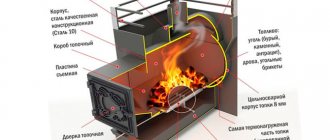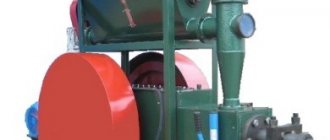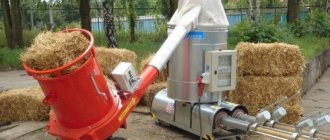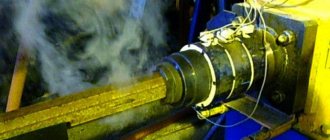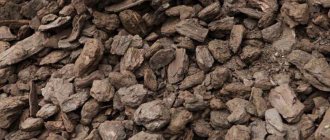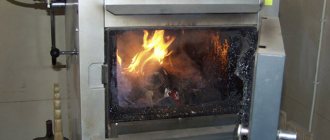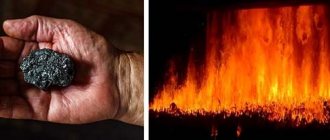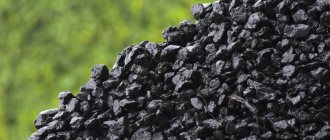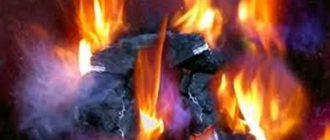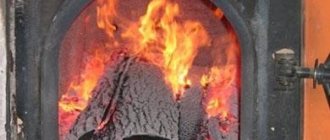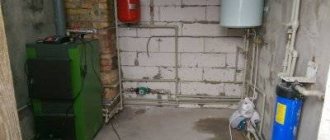What is the difference between Anthracite and hard coal?
Anthracite differs from other types of coal in its high content of fixed carbon (91-98%), low content of moisture, sulfur, volatile substances, and high specific heat of combustion. Anthracite burns quickly, without smoke or flame, with high heat transfer, and does not sinter.
Interesting materials:
How to make numbering not from one? How to make numbering not from the beginning? How to number the table of contents in Word? How to number paragraphs in Word? How to make page numbers black? How to make page numbers after a section break? How to number pages at top and bottom? How to make page numbering top center? How to make page numbering in footer in frame? How to number rows in a table in Word?
Burning coal, how to heat it, long-term burning
The quality of coal determines the amount of energy that can be obtained from it, as well as the maintenance time, the amount of ash produced, the ability to use it for heating... Which coal is better for home heating? How to burn it correctly in order to achieve maximum energy output and minimum worries?
Coal combustion temperature and other characteristics
People often ask, “What is the combustion temperature of coal?”, although this value has little effect. Other parameters are much more important.
- calorific value – the amount of heat generated per kilogram of fuel, kW/kg;
- ash content - the amount of ash that remains after burning coal, % of the total mass. It will reduce the overall calorific value, we will have to clean it from the boiler and dispose of it,
Also important:
- Caking is the ability of coals to create caked ash, which is very harmful.
- Humidity, both in-situ and introduced—isn’t it wet coal? It is better to dry wet water first under natural conditions than to burn it in a boiler with the loss of energy that will be spent on evaporation of this water.
- Volatile release, tendency to coking - coking coal grades are not suitable for heating.
More details about ash content
The ash content is as follows.
- In-situ - these are those mineral impurities, “sand and stones”, that are located inside the coal seam, in every piece of coal, and they cannot be extracted during enrichment. Good coals have up to 10% ash.
- Technical is rock that was mixed with coal during its extraction, including from large rock layers inside the coal seam, and which can be separated from coal by mechanical methods during its enrichment. The miners accidentally cut down the roof and soil of the seam - that’s extra tons, even though the ash content is high... The rock mass from the mine can have 35% ash content - it’s not at all suitable for home combustion.
It must be borne in mind that adding rock significantly enriches those selling coal. Therefore, buying coal is not an easy task. It is necessary to check the fuel for the presence of pieces of rock, including those sprinkled, directly in the carriage, in the car, before unloading. And refuse to purchase, if anything...
What is the calorific value of different grades of coal?
How much heat can we get from coal, is it enough to heat the house?
The amount of heat in kilowatts that can be released from different brands of coal compared to dry firewood is given below, kW/kg
- Dry firewood – 4.0
- Brown coals – 3.8 – 5.5
- Long flame – 6.0 -7.0
- Gas and fat – 7.5
- Lean-sintering 7.0 – 7.4
- Lean – 7.4 – 8.0
- Anthracite – 7.8 – 9.5
The most suitable thermal coal grades for home boilers are lean, anthracite and semi-anthracite. They are the ones who sinter less and form coke substances, have a minimum of ash inside the formation and better calorific value.
In addition to the brand, you need to choose a coal size class.
For advertising purposes, the seller writes on the packaging just that...
Coal size class, why they don’t burn coal dust
Coal dust and coal pellets are the cheapest and burn well, but only in special furnaces at power plants. There they burn in a cloud with fuel oil and air. And in a boiler, they simply seal the passage of air through them, so combustion inside their layer is impossible. A piece of coal does not burn in stoves, except with small additions, poured on top of the burning coal.
- You can heat it with sunflower seeds, but as a rule, it spills through the grates of all boilers...
- For home heating, more expensive fractions are used - nut and fist.
- Slab coal is even more expensive, but at home it is broken into smaller pieces.
There are many unburnt elements left in coal ash. After burning, the zealous owners sift the ash on a 5 mm metal grid, and all the large unburned parts are sent back to the boiler along with a fresh portion. This saves 10–15% of fuel.
They try to moisten coal dust into cakes, which are dried and fed into the boiler in the form of pellets.
How to burn coal correctly
If oxygen is not added to the combustion zone, then instead of carbon dioxide, carbon monoxide is formed - CO, the efficiency from incomplete combustion decreases by 20 - 50%. Modern boilers provide secondary air for afterburning CO and soot particles at high temperatures. With old equipment, with stoves, you need practical skill in supplying air over burning coals for better afterburning and preventing the release of unburned gases into the atmosphere.
Supplying a large amount of primary air directly into burning coal can turn the boiler into a forge, lead to rapid combustion of a large mass of coal, a sharp increase in the temperature of the exhaust gases up to 1500 degrees and melting of the equipment, ignition of soot in the chimney, a sharp drop in efficiency several times, from -for the removal of energy into the pipe.
The efficiency of coal combustion can be monitored by the temperature of the exhaust gases, which should not increase. There should be enough air so that complete combustion of the fuel occurs without CO and at the same time there is no increase in temperature in the chimney above normal. As a rule, modern coal boilers are able to burn fuel as required with a maximum efficiency of about 78%.
How to make coal burn for a long time
Normal long-term combustion with high efficiency is achieved better with modern equipment. But even on old boilers and furnaces, you can find the optimal approximate opening of the lower and upper dampers to ensure a normal air supply over the fuel for afterburning CO on the heat exchanger.
For example, a regular old coal stove provided the following adjustments:
- "the vent is closed"
- “the two upper burners are slightly open”,
- then the portion of coal smolders - long-term combustion occurs, but the afterburning of the gases is, as a rule, complete.
In modern boilers, such modes are monitored by the equipment itself.
High-power coal boilers (large load possible) from well-known manufacturers with secondary air supply are suitable as a cheap and universal option for home heating. They can be used to burn a large load of coal for a long time by redistributing the air supply.
Automated boilers are becoming more and more popular now. Their combustion duration is ensured by a coal bunker and a constant supply of small portions to the combustion zone. Moreover, the equipment is not necessarily too expensive. Boilers with a bunker from which fuel is loaded under its own weight have an affordable price. Boilers with screw feed are more expensive, but they can do a little more. Thus, the bunker allows you not to worry about adding fuel every day. Combustion occurs, as a rule, in small portions, but with a full supply of air without the formation of large volumes of CO - European environmental requirements for equipment.
In any case, the increased burning time of coal will be ensured primarily by equipment for large loads - in a bunker or directly in the furnace. The choice of a boiler for coal is based on this consideration.
Which coal to choose
Coal occurs in the earth's crust in the form of layers. Each of them is labeled and has its own quality characteristics. But even in the same seam, but in different areas, coal can vary greatly in quality - the degree of metamorphism, the amount of ash, volatiles, sulfur, humidity change...
For energy purposes, the most valuable coals are those with the highest degree of metamorphism, with the highest percentage of carbon C in the composition. These are Anthracites and those close to them, which are assigned the brands Semi-Anthracites and Lean Coals.
The best coals for heating will be anthracite and semi-anthracite from the processing plant, walnut and fist fractions.
By region of production, the best thermal coals were previously mined in the Donbass, but recently production has been greatly reduced, and such coals are difficult to find on the market. In any case, the anthracites of the Donbass layers H2 Removsky, N2-1 Podremovsky, N-8 Fominsk were considered the best for home heating. There is a known record for the calorific value of a kilogram of coal mined in the 70s from the Fominskaya seam with a value of 9800 kW/h - practically pure carbon...
Now it is cheaper to purchase coal from Kuzbass and Ekibastuz, despite the long delivery. You need to ask for coals from the energy layers of Kuzbass.
The purchased coal must contain a minimum amount of:
- tufts, dust, which practically do not burn and have a bad effect on the combustion process, filling the boiler, limiting the access of oxygen to large pieces;
- rocks - pieces of rock in coal - this is a waste of enrichment or a special mixture at different stages of trade.
It is better to immediately warn the seller that you will refuse to purchase coal with a piece and rock. Order walnut and fist coal fractions in small portions to check; as a rule, the seller has a supply for the whole season, and you can buy additional fuel if it is of good quality.
Why is coal watered?
4. Loading fuel, as a rule, should begin from the front of the grate, avoiding the formation of burnouts, achieving an even, dazzling white fire over the entire area of the grate.
5. When loading fuel, after each thrown shovel of coal, you should close the door of the scoop hole, producing heating with a slam; This technique prevents excessive cooling of the firebox.
6. Throwing in coal should be done as often as possible, in small portions of 4-6 shovels, avoiding loading in a heap, but throwing in the coal loosely, like a fan.
7. During steady combustion, fuel should be added crosswise, covering only part of the burning layer with a fresh layer.
8. The air flow into the firebox should be adjusted according to need, combining the opening of the siphon, the blower valves and the position of the variable cone bulb, avoiding sudden changes in the combustion process.
9. The use of cutters and lances, inevitable during prolonged heating, requires great care. Taking into account the individual properties of burning fuel, it is necessary, if possible, not to destroy the coke layer and not mix it with the slag.
10. Heating on the way should be carried out taking into account the nature of the profile and with continuous monitoring of the layer of burning fuel. If there is a heavy area, you should begin to increase the load on the firebox and boost the heating in advance. Towards the end of a difficult section, it is necessary to gradually reduce the load on the firebox, gradually weakening the intensity of combustion.
11. Heating should be carried out in strict accordance with the water supply to the boiler. The boiler must be fed through the injector in small portions in the intervals between two loadings of fuel, not allowing the steam pressure to decrease by more than 0.5 atm during the pumping of water.
12. Approaching the final station or an intermediate point where the furnace is cleaned, you should gradually reduce the fire, burning out the coke in the layer and burning it out of the slag.
Preparing coal before loading it into the furnace
Wetting of the coal should be done during the next pumping of water into the boiler, avoiding special pumping only for watering. When wetting the coal, it is necessary to mix it, bringing the mass of coal to the state of a uniform, steep, dough-like slurry. The more fines the coal contains, the more abundantly it should be moistened. However, we should not forget that excessive wetting is harmful.
Wetting of coal has as its main task to reduce the entrainment of fine dry coal into the pipe. In addition, the water contained in the moistened coal, entering the firebox with it and evaporating, leaves small funnel-shaped channels in the burning layer. These channels increase the surface of contact between the air and the fuel layer and thereby contribute to good, active combustion.
Operating principle of a coal boiler
To figure out how to properly heat a boiler, you first need to consider its structure and understand the principles by which such equipment operates. The structure of any coal boiler includes two main compartments. The upper compartment is the firebox, in which the process of converting solid fuel into thermal energy occurs. The lower compartment is designed to collect ash and slag that remains after coal combustion. The compartments are separated by a grid made of high-strength cast iron.
Quite complex automation can be built into the boiler design, which makes it possible to configure the operation of the system so that the draft is regulated independently, without the need for constant intervention. In the absence of automation, the boiler operates due to natural circulation. The first category of devices is much more convenient, but they also cost an order of magnitude more than simple boilers.
Automation works on very simple principles. To ensure the combustion process, the boiler needs oxygen, which, if automatic, is supplied by a fan. An increase in the amount of oxygen in the firebox accelerates the combustion process, and a decrease in the intensity of the air supply leads to the opposite effect - the fuel burns more slowly and releases less heat.
The temperature of the boiler is regulated by a special sensor, which allows you to program the operation of the device. When a certain temperature is reached, the sensor turns off the fan, causing the rate of fuel combustion to decrease. The decreasing temperature forces the automation to restart the oxygen supply and resume active combustion.
Features of kindling
If the heating device is not being used for the first time, then before igniting it, you should remove all the ash that has accumulated inside. A similar procedure should be carried out once a year at the beginning of the season. If you do not take care of the stove, then soot is deposited on the walls inside it, as a result it takes longer to warm up, requires more fuel, and the percentage of heat transfer decreases.
The same applies to the grate. This element must be clean, because if it becomes clogged, the combustion intensity decreases due to the lack of normal air circulation.
Ideally, dry materials should be used for the firebox, but if these are not available, then it is permissible to fill the stove space with wet wood or coal. The only thing you should know is that in this case a larger amount of soot will settle on the walls, and accordingly, cleaning will need to be carried out more often.
Wetting - coal
Some experimental studies on the influence of the gas phase on the wetting of coal with cryolite-alumina melt were carried out in 1952 by Vaina [37], and then by the authors of this book. Lastly, to establish the influence of the gas phase and at the same time the composition of the salt phase, we measured the contact angles of melts of the systems: A1F3 - NaF and Na3AlF6 - A12O3 on carbon plates in an atmosphere of Ar, N2, CO2 and air. The results of these measurements show that the value of the contact angle 6 depends on the gas phase in the following way: the smallest values of the contact angles for all the studied melts were obtained in an air atmosphere, and the largest in an atmosphere of dry argon. [16]
The optimal moisture content of coal should be about 50%; at this humidity, the wetting of the coal occurs most evenly and, therefore, the interaction between humic acids and ammonia is most complete [3, p. Low humidity leads to large losses of nitrogen, since ammonia water is slowly absorbed by coal . [17]
The nuances of firing stoves with coal in winter
In winter, at low temperatures, it can be quite difficult to light the stove. In addition, the special draft that is formed due to cold air does not allow smoke to escape freely. There is no way to light the stove quickly. You can improve the kindling process by using a hairdryer, which warms up the inside of the heating equipment.
Such heating of the furnace device will avoid smoke, which is typical for cold structures. The stove should be warmed up several times a day in winter so that the system does not have time to cool down too much.
Coal is considered the most efficient type of fuel. It is successfully used to kindle stoves. The level of heat transfer of such raw materials is higher than that of wood raw materials. A good result from using coal for a stove can only be obtained by following all the rules for kindling and operating the heating device.
